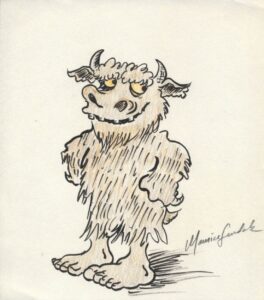“In the beginning was the Word, and the Word was with God, and the Word was God.” – John 1:1 KJV
When I think about creative works generated by generative AI, I think about golems. According to legend, Rabbi Yehudah Loew created a automaton from clay to protect the Jews of Prague by animating a soulless lump of clay with the Word of God. Like the Rabbi of folklore, when we write or produce a work of art, we like to think we’re doing something that imbues our work with soul. People say an image created by GenAI lacks the “creative spark”, but what does this really mean? What distinguishes an illustration by Sendak or Doré or Geiger from a similar work created by prompting Midjourney?
Imagine Hugging Face puts on an event where they put a generated illustration next to a work from a famous illustrator and ask an art critic to point out differences. The art critic will get deep in the weeds and point out various differences, then they’ll ask another art critic, who’ll emphasize different distinctions, then another will identify still others as crucial and then Hugging Face will say, “Aha! The critics couldn’t reproducibly find differences and therefore there really are none!” Lots of breathless media headlines and dunking on critics will ensue, unless…
Unless we are clear about where the magic of creation really comes from. Insisting the creative spark is in the work product is like believing you could literally animate clay if only you could find the right sequence of Hebrew characters to inscribe upon it. So where is the magic, then? It’s in the process. We create to be transformed by the process of creation. When we write, we’re not merely giving birth to something already fully-formed in our heads. We’re co-creating with the tools we use and the audience we imagine and the medium we express in.
This way of thinking about the magic of the creative process is backed by modern cognitive science. According to 4E cognitive science, thinking isn’t something that only happens in your head; it’s embodied, embedded, enacted, or extended through processes and systems existing in the world. The choice of writing tool and platform affords longer or shorter text and the amount that’s visible at once changes the “attention window”, so your thinking can be said to be embedded in these tools. If you use an LLM as a writing assistant, your thinking is extended by the tool. Your awareness of your audience enacts a world wherein some topics are more or less salient, and the physical act of sitting down to write and getting into a flow state is very much an embodied practice.
So the important question isn’t whether your work has some special spark that LLM output doesn’t have. The question is how were you transformed by the process? Did you develop a relationship with the ideas and did your understanding of the topic change as you wrote? Did the work develop from an infantile first draft to an adolescent revised version? Will it reach adulthood in thoughtful discussions with readers?
This to me is why we create and nothing about the existence of LLMs changes this.


